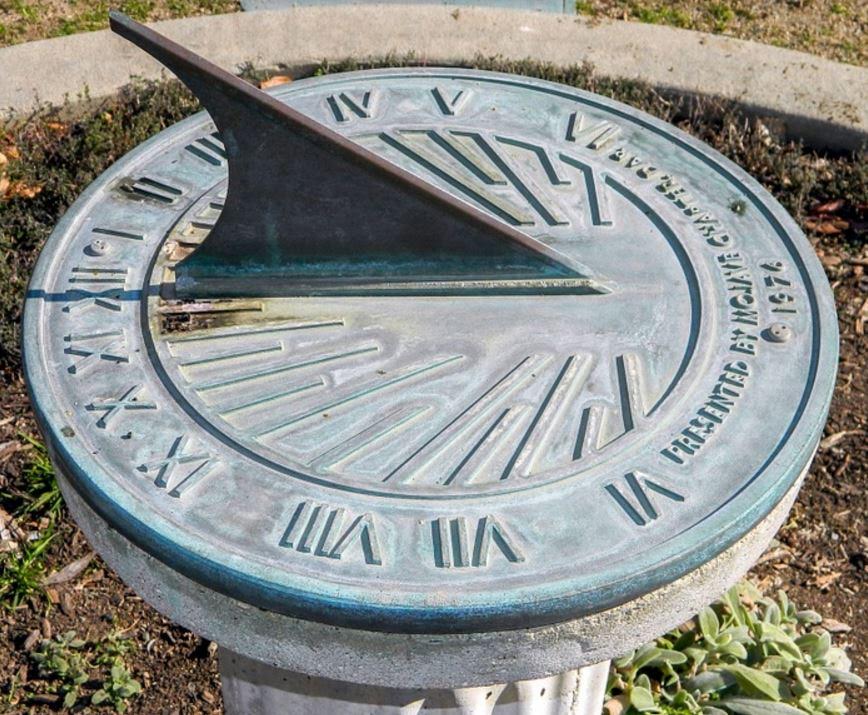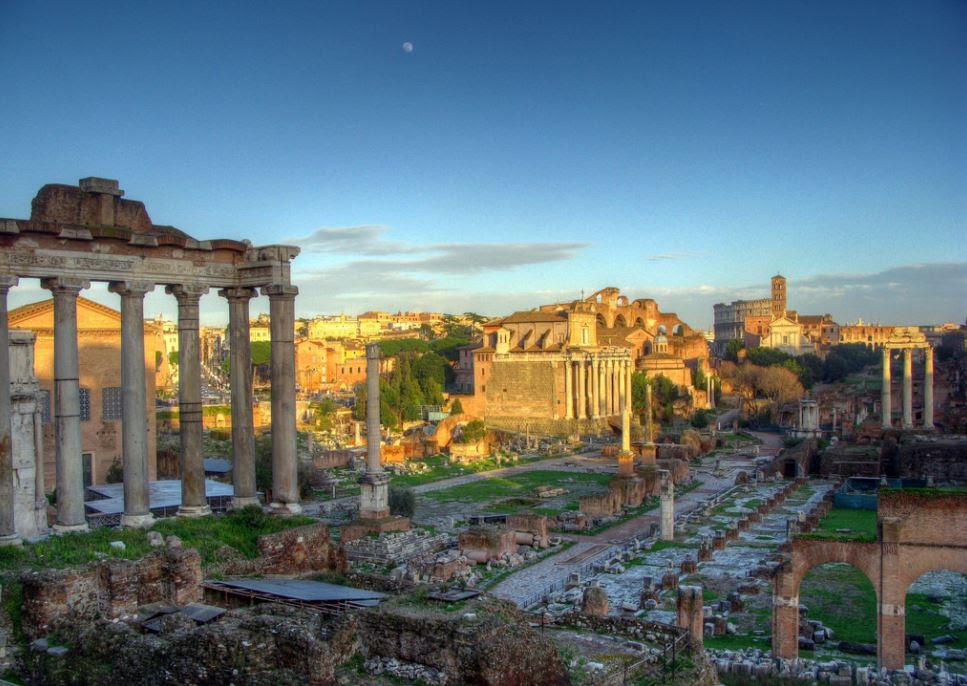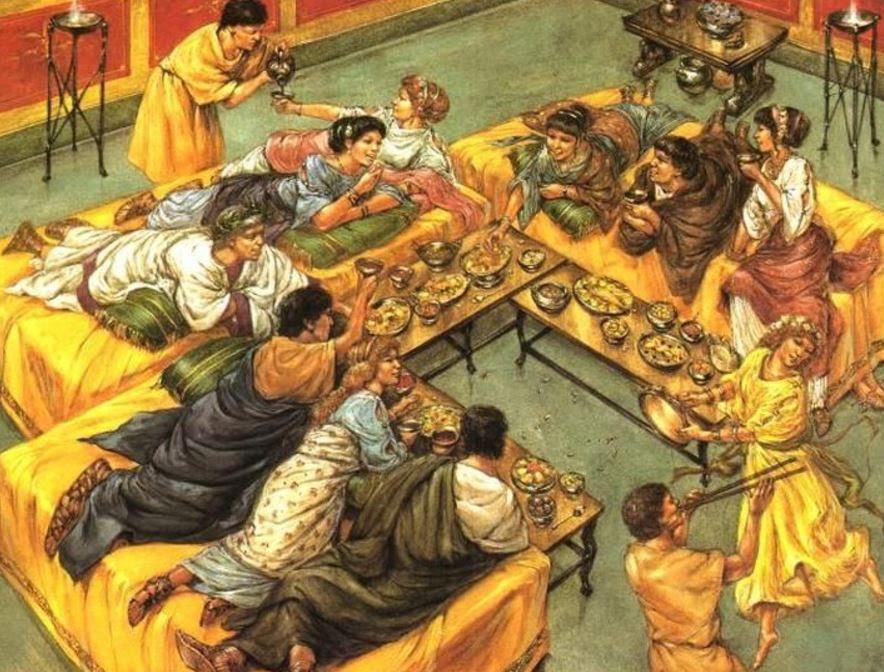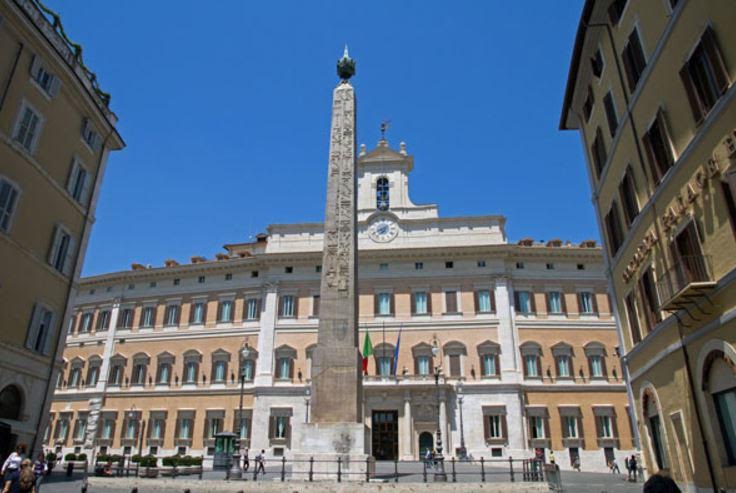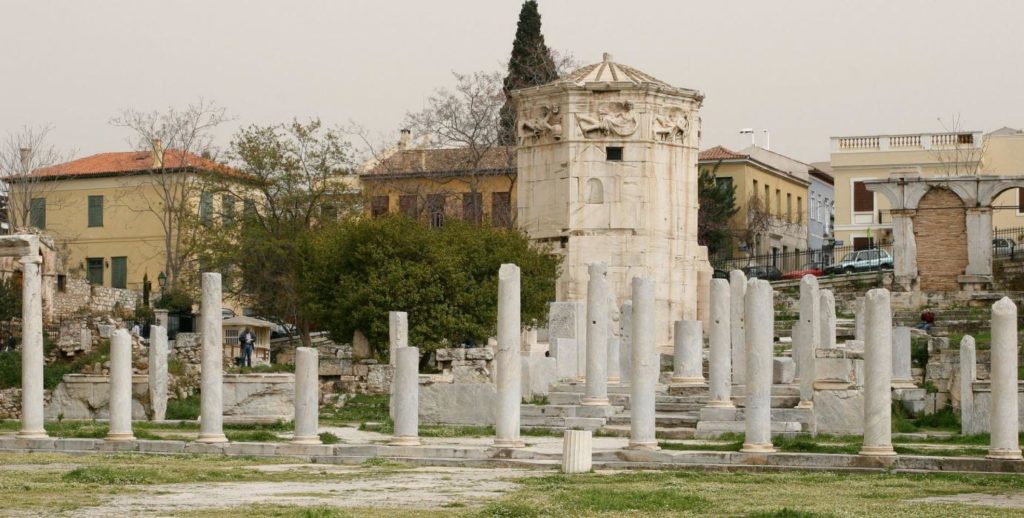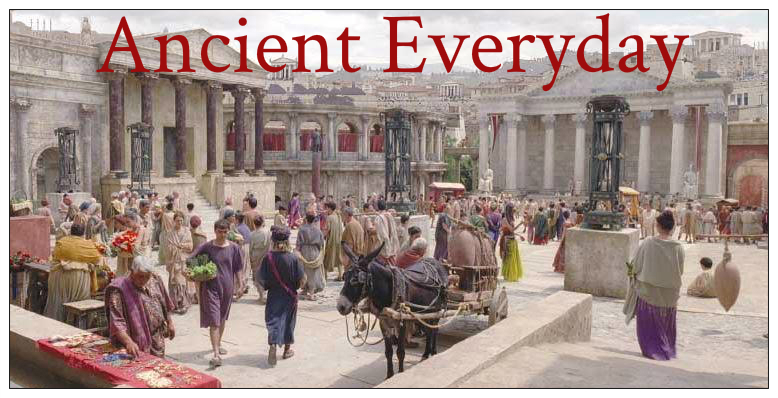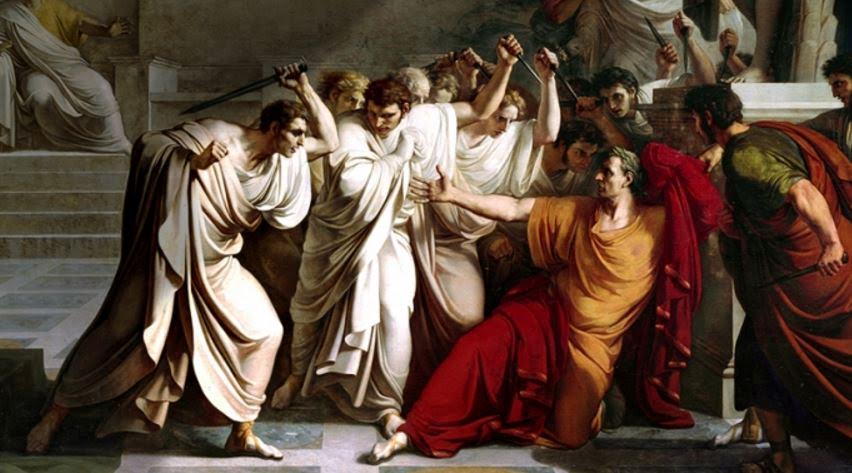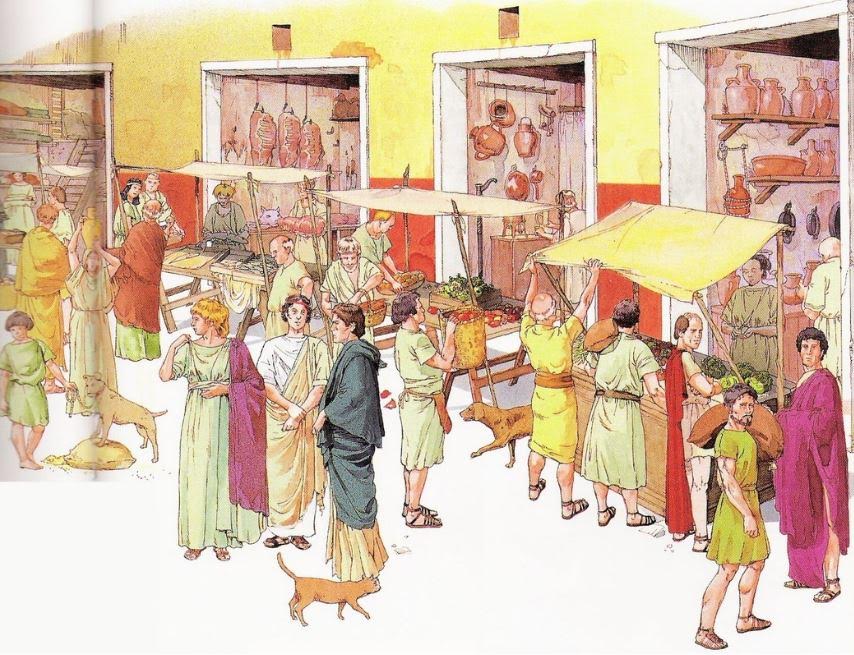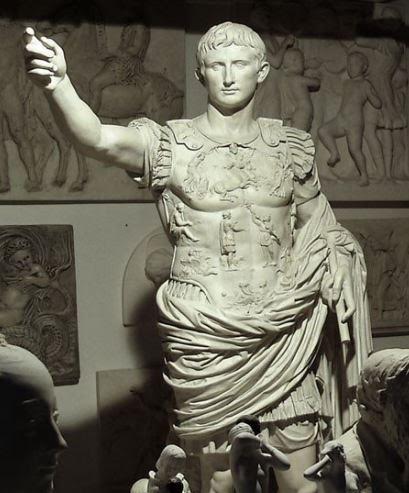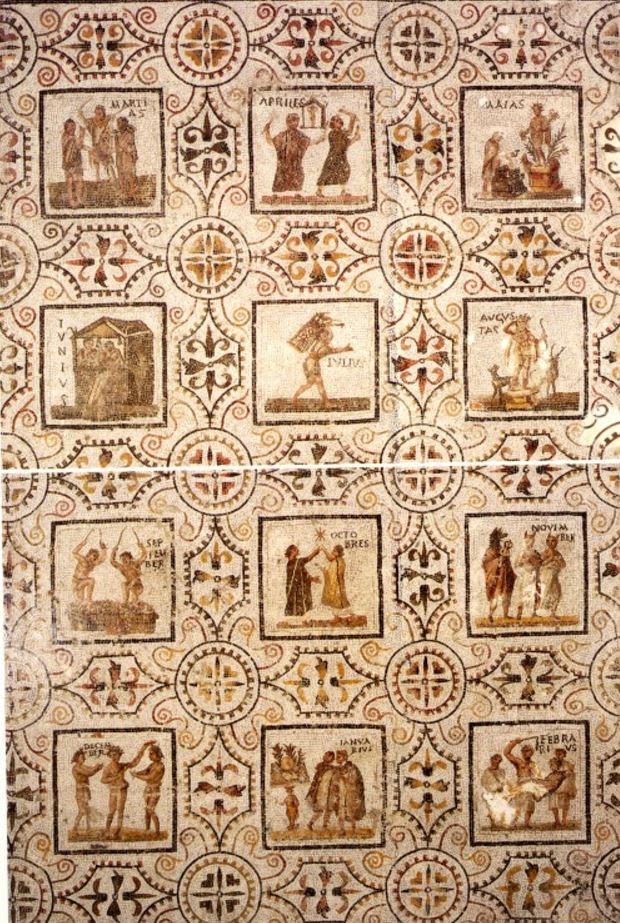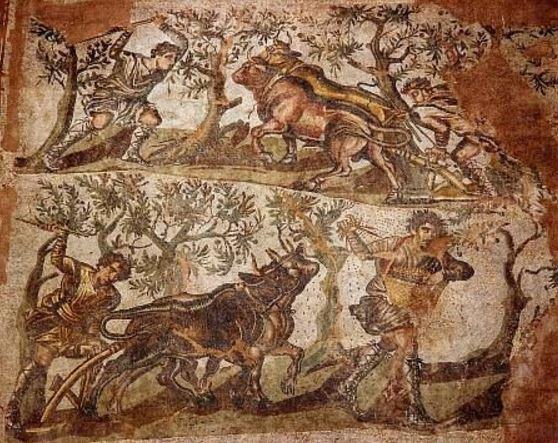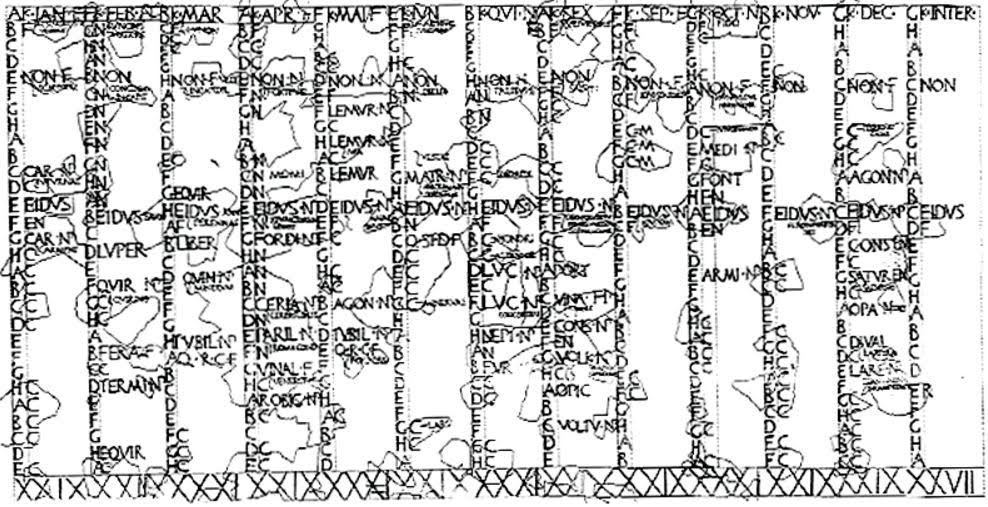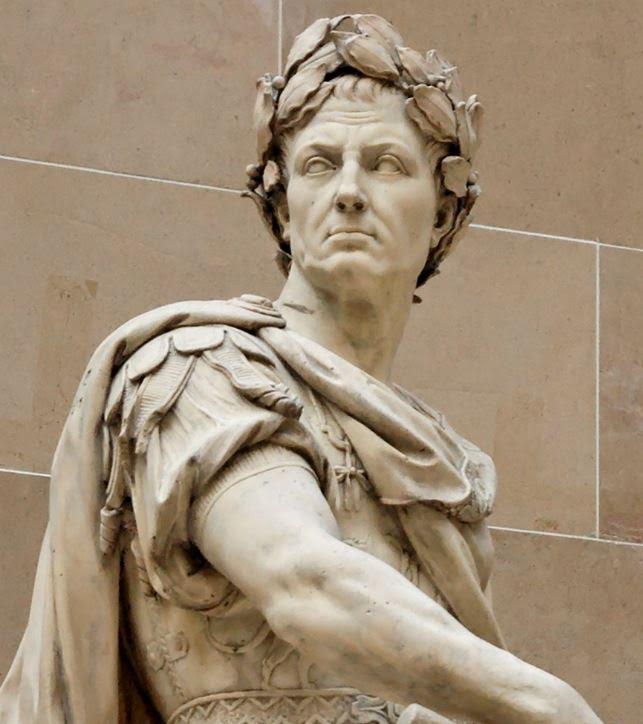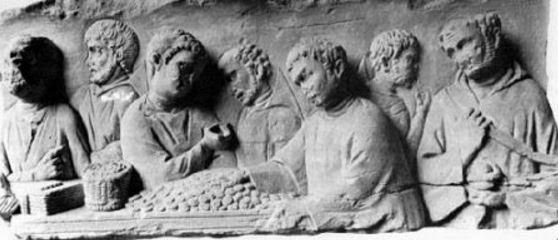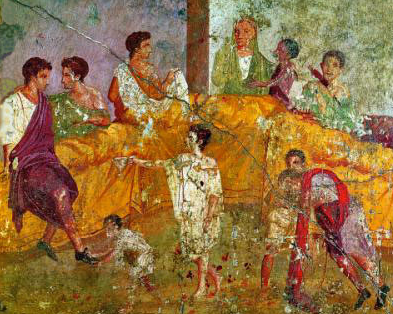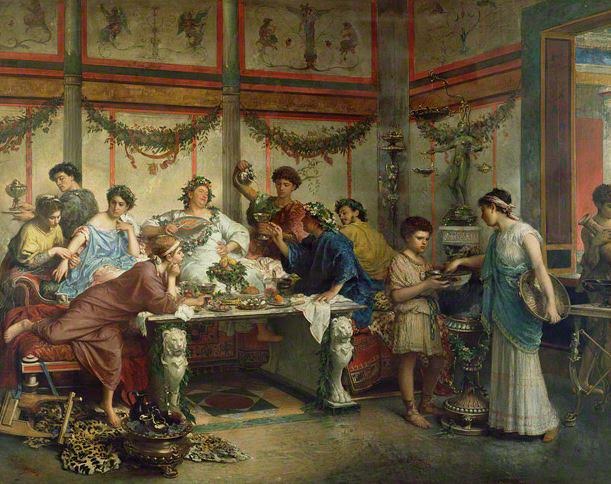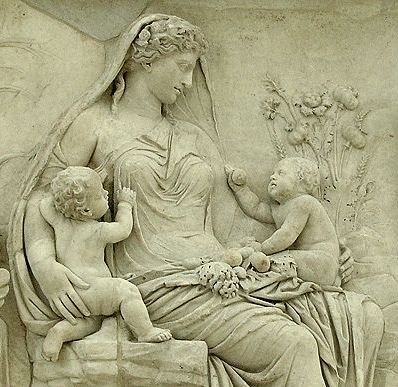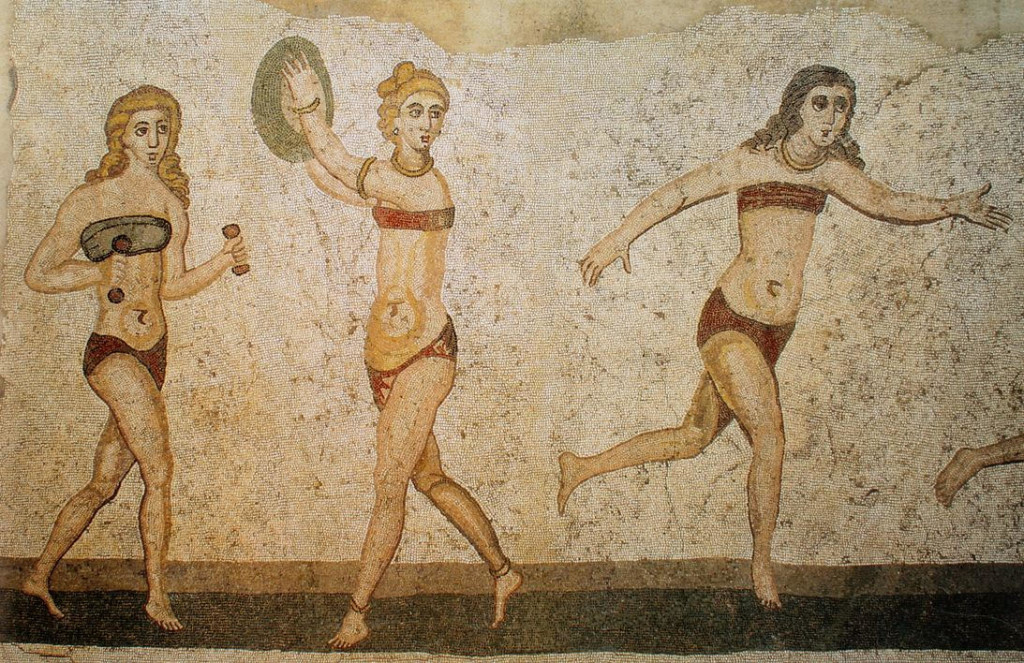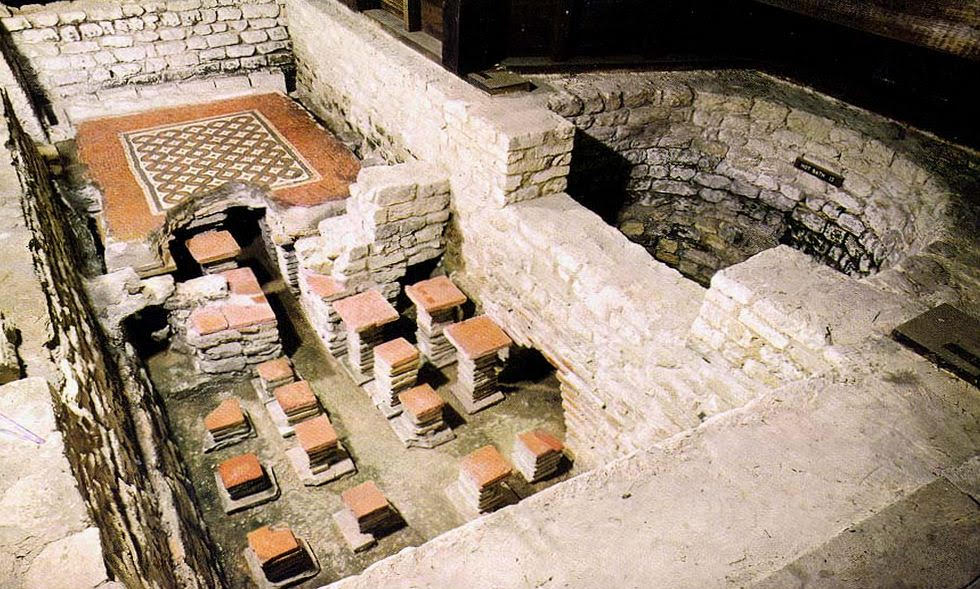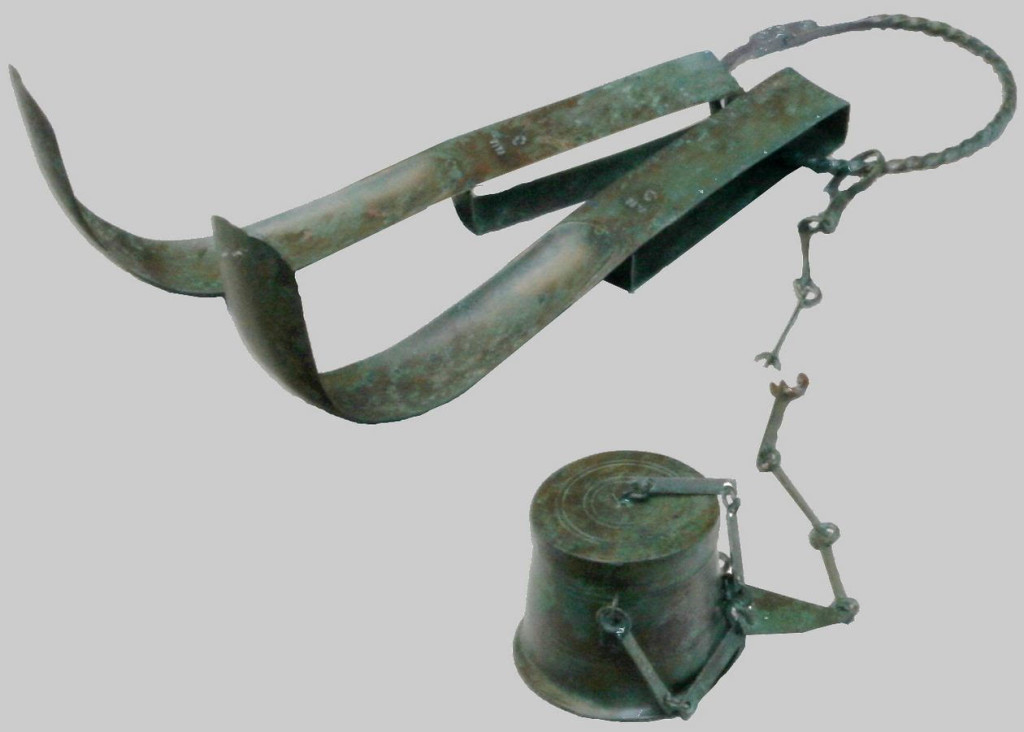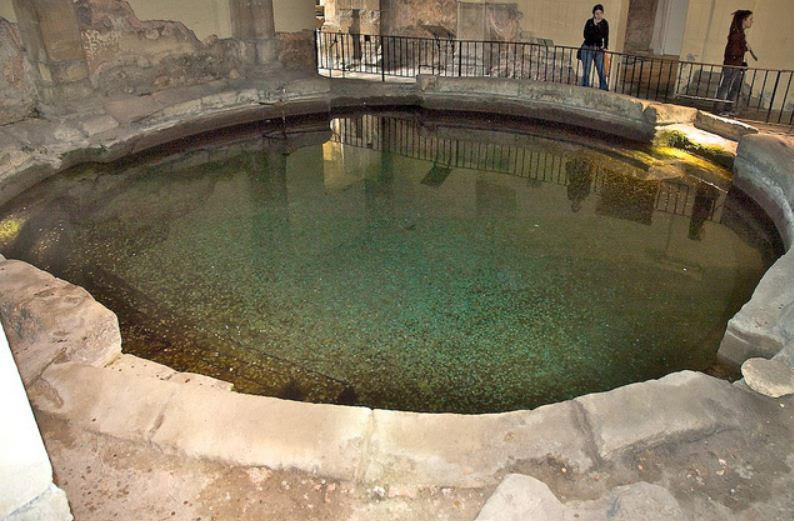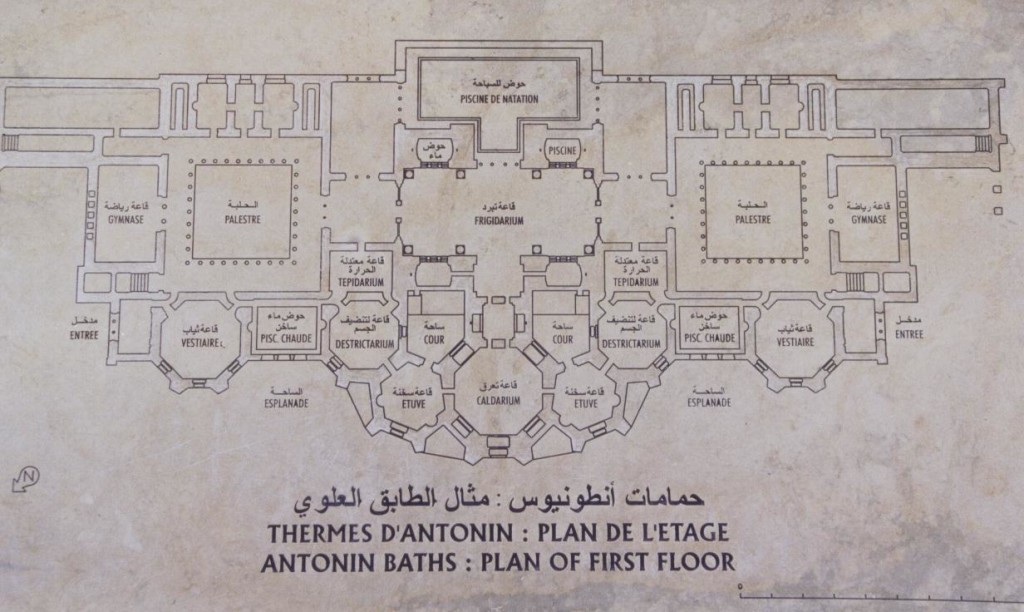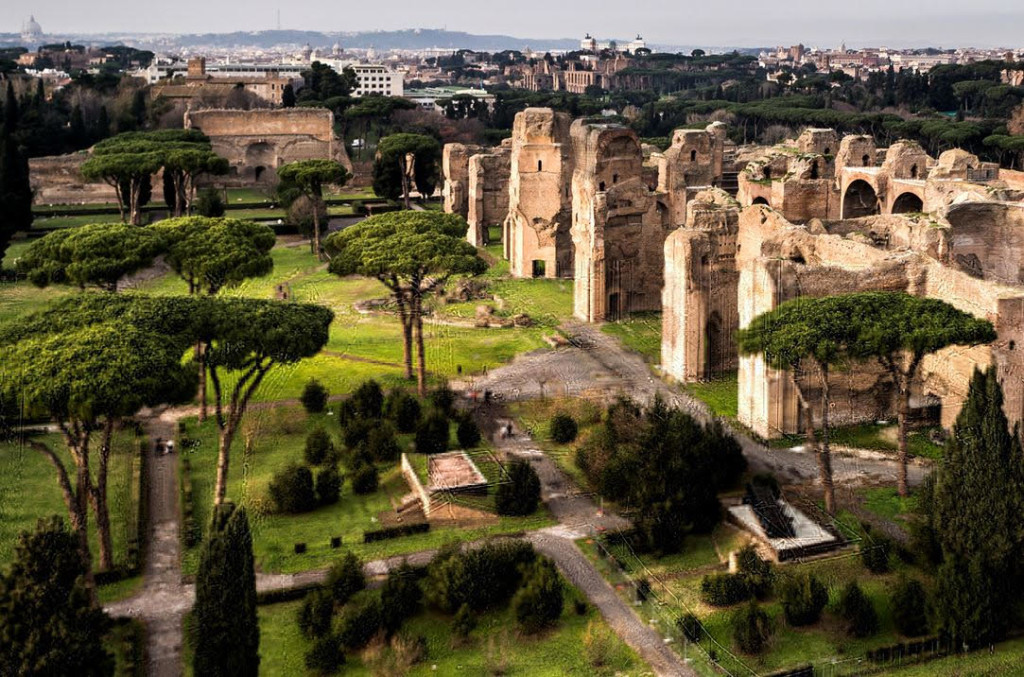Ancient everyday
Ancient Everyday – The Days and the Weeks in Ancient Rome
Salve readers!
We’re back in the Roman world for the third part in this mini Ancient Everyday blog series about, you guessed it: Time.
In the last two posts, we looked at how Romans tracked the years, as well as the evolution of the calendar in ancient Rome.
Today, we’re going to take a brief look at the Roman days and weeks which, in addition to many things, are one of their legacies to us.
The Roman days of the month were not numbered serially as they are today. They were numbered in relation to three specifically named days. It was from these three specific days that the other dates were counted retrospectively.
So, what were these special days, you might ask? They were the:
Kalendae
(the Kalends – first day of the month, and origin of our word ‘calendar’)
Nonae
(the Nones – the ninth day before the Ides, or the fifth day of the month; seventh in a 31-day month; originally, the Nonae corresponded with the first quarter moon of the lunar month)
and
Idus
(the Ides – the thirteenth day; or the fifteenth day in a 31-day month; the Ides originally corresponded with the full moon of the lunar month)
So, those are the ‘special’ days in the Roman month. But how did they count the rest?
This is where it gets complicated…
The day was numbered or named by its place so many days before (ante diem) the Kalends, the Nones, or the Ides of the month.
But! The day immediately before one of the three named days was called pridie.
If you ever try to read Roman dates, you will also notice that they are always abbreviated.
In ancient Rome, the official Calendar was drawn up by the pontiffs (priests) who ensured the inclusion of the dates for religious festivals – and in ancient Rome, there were many of those! These festivals would be indicated by a letter or abbreviation representing a particular celebration beside the date.
So, those are the days of the Roman calendar, but what of the weeks? Did they have the exact same weekdays that we do? Or rather, do we have the same ones as the Romans?
Not exactly.
Early on, the Roman week was eight days long. The eighth day was a market day, or nundinae.
The market day was a day of rest from agricultural labour, a time to take the produce or livestock to market.
To confuse things a little more, the period of time between market days was known as a nundinum.
The eight-day week did not last however.
The seven day period that we are familiar with was used at first in the East, especially by Hellenistic astrologers.
In Rome, the earliest reference to a seven day week is supposedly from the time of Augustus (27 B.C. – A.D. 14). This was eventually officially adopted by Emperor Constantine in A.D. 321.
Finally, what were the names of the days of the week in ancient Rome?
Well, they were named after the gods and planets, and to this day the names used in the various Romance Languages preserve the Roman tradition. Beginning with Monday, they are:
Dies Lunae (the day of the Moon)
Dies Martis (the day of Mars)
Dies Mercurii (the day of Mercury)
Dies Jovis (the day of Jupiter)
Dies Veneris (the day of Venus)
Dies Saturni (the day of Saturn)
Dies Solis (the day of the Sun)
There you have it, the Roman days and weeks!
The legacy of the Romans never ceases to amaze me.
Next week is the fourth and final part of this Ancient Everyday blog series in which we will be looking at how the Romans told the time of day.
Until then, thank you for reading!
Ancient Everyday – The Calendar in Ancient Rome
Salve!
Welcome to the second part in this mini, Ancient Everyday blog series about Time in the Roman world.
Last week we took a brief look at how the Romans tracked and organized the years. If you missed it, you can read it by CLICKING HERE.
This week, we’re going to take a look at what is perhaps one of their greatest legacies – the Calendar.
Now, the Romans did indeed do a lot for us – you can check out this wonderful series hosted by Adam Hart-Davis to learn what the Romans did for us – and it goes without saying that we take a lot of it for granted today.
The calendar ranks right up there, and even though we take time for granted, it is actually something that we are constantly aware of. Quite the conundrum, if you ask me!
The word ‘calendar’, as well as the names of the months we still use today are of Roman origin.
However, the calendar went through some reform before it got to the version we are now familiar with.
The original Roman calendar, known as the ‘Calendar of Romulus’, was an agricultural, 10-month year. There were ten irregular months with a total of 304 days from March to December.
The names of these months originated then, and the gap of missing months accounts for the period of time in which no agricultural work was carried out. This was also a lunar cycle, so there was a degree of ‘seasonal drift’ compared to the solar cycle.
It is believed that the change to a 12-month calendar occurred in the sixth century B.C.
In the year 153 B.C., January was made the first month of the year, named after Janus, the god of doorways and new beginnings.
But until Julius Caesar’s calendar reform, the Roman year was 355 days long, divided into 12 months. Four of these had 31 days (March, May, July, and October), seven months had 29 days, and February had 28 days.
Here are the names of the months on the Roman calendar:
Ianuarius (the month of ‘Janus’)
Februarius (the month of ‘Februa’, purgings or purifications)
Martius (the month of ‘Mars’)
Aprilis (uncertain meaning)
Maius (uncertain meaning)
Iunius (the month of ‘Juno’)
Quinctilis (the ‘fifth’ month – renamed ‘Iulius’ in 44 B.C. after Julius Caesar)
Sextilis (the ‘sixth’ month – renamed ‘Augustus’ in 8 B.C. after Emperor Augustus)
September (the ‘seventh’ month)
October (the ‘eighth’ month)
November (the ‘ninth’ month)
December (the ‘tenth’ month)
Notice how some of these names are a legacy of the 10-month agricultural Roman calendar year?
There is apparently some evidence for ‘intercalation’, that is, the addition of days to adjust the year. This included the addition of 22-23 days every other year in February.
The act of intercalation was the domain of the pontiffs of Rome, but it was not accurate, and by the time of Julius Caesar, the civic year was about three months ahead of the solar year that was in use.
Caesar extended the year 46 B.C. to 445 days to remove the discrepancy.
So, from January 1st, 45 B.C. he made the year 365 days long with the months at their current numbers. Quite the legacy, no? He also introduced the leap year.
Thus, was the Julian Calendar born.
Today, the most widely used calendar is the Gregorian Calendar. However, the Gregorian calendar is basically the same as the Julian Calendar except for some small changes.
In 1582 Pope Gregory XIII omitted 10 days from the calendar year to adjust the discrepancy between the Julian calendar and the solar year. He also ordered that 3 days be omitted in leap years every 400 years.
So there you have it! A very brief look at the evolution of the calendar from ancient Rome to the one we use today.
Next week, in Part III of this series, we’ll be looking at the days and weeks in the Roman world.
Thank you for reading!
Ancient Everyday – Tracking the Years in Ancient Rome
Salve!
This week on Writing the Past, we’re going back in time from the Middle Ages to ancient Rome once more.
I thought it might be fun to do a short series of Ancient Everyday blogs about something that concerned our ancient ancestors as well as ourselves. It’s something that, across the ages, we all wish we had more of: Time.
This isn’t going to be a philosophical series of posts on time, but rather a look at the practicalities of time and how ancient Romans organized it.
In this first post, we’re going to look at how years were counted and tracked in ancient Rome and across the Empire.
Today, dating is something we take rather for granted, but at times during the Roman era, there was a lot of thought put into this and the development of a system around it.
Early in the Roman Republic, the years were usually dated by the names of the Roman Consuls, the highest rank for an elected Roman official, and the pinnacle of the Cursus Honorem, the tried and true path of public offices for anyone seeking political success.
Two consuls served at once and, conveniently, they served for just one year, so that could be readily used as a method of dating. The lists of consuls were called fasti, and they exist from about the year 509 B.C.

Fragment of the list of the Roman consuls known as the “Fasti Colotiani” (Museo della civiltà romana)
This practice of dating using the names of Roman Consuls stopped in about A.D. 537 when Emperor Justinian I (the ‘Great’) switched to the regnal years of the emperors.
Prior to that, there were other ways in which the years were tracked and counted.
Sometimes years were dated from the founding of the city of Rome – ab urbe condita was the wording used. Rome is generally thought to have been founded in the year 753 B.C., so the years would be counted from that point on.
I wonder how widespread this dating was, compared with the use of the fasti. There were even more dating systems across the Empire, systems which had a local flavour; say, for instance, years counted from a particularly big event in the history of a certain place etc.
From the late 3rd century A.D., the practice of counting years by indiction, or indictio, was also used. This was the announcement of the delivery of food and other goods to the government. So, basically, indictio referred to the tax assessment which took place, at first, in five-year cycles, but in a fifteen-year cycle from about A.D. 312.
Indictio was also often used to date the fiscal years in the Empire which tended to begin on the first of September.
It’s thought that the general population may have tended to know the indictio years better than the consular years. This isn’t surprising as we’re all aware of the dates when the government slashes at our purse strings!
The Christian reckoning of years using B.C. and A.D. (for Anno Domini – ‘Year of the Lord’) in the Julian and Gregorian calendars was introduced in the mid-sixth century by the monk Dionysius Exiguus of Scythia Minor. In this reckoning, there is no year ‘0’, but rather 1 B.C. is immediately followed by A.D. 1. Nowadays, there is a movement toward using B.C.E (Before Common/Current Era) and C.E. (Common/Current Era).
Whichever method of dating you prefer today, it seems that the Romans had a variety of methods to choose from.
Were they as obsessed with time as we are today? I suspect not. But it was something they grappled with on certain levels.
Either way, ancient dates are likely less reliable before Julius Caesar’s calendar reform of 45 B.C.
I suppose we should thank the gods for circa, that is, ‘approximately’!
Thank you for reading!
If you are curious and want to check out a list of the consuls of Rome, you can do so by CLICKING HERE.
Come back next week for the next Ancient Everyday in this series on Time in which we’ll be looking at the Roman calendar and months.
Ancient Everyday: Paterfamilias – The Father in Roman Society

It’s been a while since our last Ancient Everyday post, so time to get back to it.
Today, we’re going to look at the father in Roman society, the paterfamilias.
As an example, we are going to use Quintus Metellus Anguis, one of the main characters from the book, Killing the Hydra.
Looking back on the writing of this book, I forget all the years of research that went into it. I take for granted the everyday Roman world I immersed myself in to write it and the rest of the series. It all seems quite normal to me now.
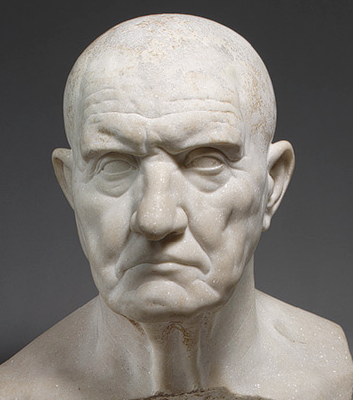
Republican portrait of a man
I’ve spent a lot of time with the characters – the good, the bad, the savage, the honourable, the beautiful, the mysterious etc. etc., but Senator Quintus Metellus Anguis was a difficult person to deal with. However, I’m not sure he would have been out of place in the early Republican era.
Quintus is a spiteful, hard man who is quick to anger and jealous of his son’s (that is, Lucius Metellus Anguis’) successes. He is of a mindset that was born in the very early days of the Republic when there were no emperors, when kings were killed, and when the father held supreme power in the family.
Then again, in some ways, Quintus Metellus could not be more out of place in early 3rd century Rome, the period during which the story takes place.

Imperial Family under Augustus
Let’s take a look at the father in ancient Rome and his role as paterfamilias.
First we should have a look at the word familia. In ancient Rome, a familia did not only include a father, mother and children. The word also referred to other relatives (by blood or adoption), clients, freedmen and all slaves belonging to the family. It included all the family houses, lands and estates and anyone involved with running those holdings.
The Roman familia went far beyond the nuclear family, and the paterfamilias was the head of it all.
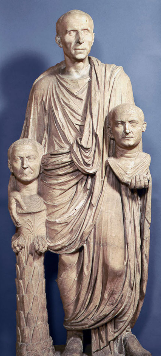
Roman Man and his ancestors
During the early days of the Roman Republic, the role of the paterfamilias was largely determined by an unwritten moral and social code called the Mos Maiorum, or the ‘ways of the elders’. These governing rules of private, social and political life in ancient Rome were handed down through the generations. Because these rules were unwritten, they evolved over time. Values and social mores change, as is natural, and successive generations come into their own with ideas different to their predecessors.
The generational differences form a large part of the conflict between Lucius and his father Quintus in both Children of Apollo and Killing the Hydra.

Roman Youth – in this case, Marcus Aurelius
Quintus Metellus, as a Republican, is against Emperor Septimius Severus. He has had a vision of his son’s social and political progress since before he was born. He has tried hard all his life to breathe life back into the ancient name of ‘Metellus’, but without success. Now, all the pressure is placed upon his son, Lucius, whom he wants to become a senator of renown after he completes his minimum number of years in the military.
But Lucius has other ideas. He does not want what his father wants. Lucius has found success in the Legions and has been praised and promoted by Emperor Severus, a man he is happy to serve. Unlike many equestrian youths, Lucius Metellus Anguis is not interested in pursuing a political career. He wants to be a career officer in Rome’s Legions – something that causes his father no end of embarrassment and frustration. In his opinion, it is not the way to further the family name and better their fortunes.
In the early days of the Republic, Lucius would have had to do as his paterfamilias dictated. There would have been no choice in the matter, no influence from his mother or older sister to help his cause. The paterfamilias’ word was law within the familia.
In ancient Rome, the paterfamilias had to be a Roman citizen. He was responsible for the familia’s well-being and reputation, its legal and moral propriety. The paterfamilias even had duties to the household gods.
And this is where Quintus Metellus fails. He has lost faith in the gods that have watched over them. In fact, he fears them and their apparent favour of his son. Quintus clings to the archaic role of the paterfamilias like a dictator with power of life and death over the members of his familia. He forgets that the paterfamilias’ role is also to protect his familia within the current world they live in, and to honour their ancestors and their gods through his behaviour, his example.
This is where Lucius fills the void in duties neglected by his father.
But it is never as easy as that. The Empire is large, and most men are susceptible to corruption. Lucius fights for honour and goodness in a world that has no qualms about dismissing honour, virtue and family in the interests of greed and political advancement.
Quintus Metellus is the paterfamilias of their branch of the Metellus gens, but his own shortcomings and archaic notions are at complete odds with his son and the times they live in.
It’s always interesting to compare previous ages and practices with those of our own. Certainly the role of the father has changed over the centuries, though it varies from family to family and culture to culture.
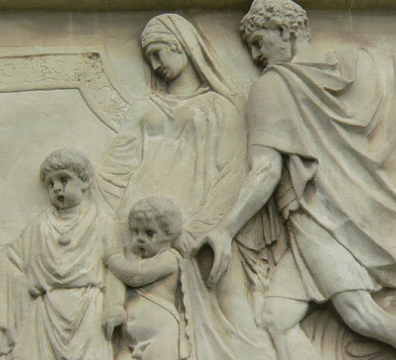
Roman husband, wife and children
Fortuna smiled on me with my own father who, thankfully, bore no resemblance to Quintus Metellus. But it was interesting to write such a character as Quintus, to explore his relationship with Lucius and the rest of the familia.
By the 3rd century A.D. the paterfamilias’ power of life and death over his family was restricted, the practice all but dead.
But old habits and ideas die hard, and for Quintus Metellus there are other ways to kill a member of your familia and maintain your power as paterfamilias.
Thank you for reading.
Ancient Everyday: Medicus! – Physicians in the Roman Empire
Going to the doctor’s office is never something one looks forward to.
For most, myself included, it gets the heart rate and stress levels up to step into a building that’s full of ‘sick people’.
Sitting around in a waiting room with a group of scared, nervous, fidgety folks, is enough to drive you mad, and the sight of a white coat and stethoscope makes one want to run screaming from the building.
It was probably the same for our ancient Greek and Roman ancestors. Most civilians would have been loath to visit with a physician. It might not have been someone you wanted around, unless absolutely necessary.
‘Oh dear. That cough doesn’t sound good, my dear Septimius!’
Not so for the soldiers in the field.
I’m not an expert in ancient medical history, but I do know that the level of injury on an ancient battlefield would have been staggering. The sight or sound of your unit’s medicus would have been something sent from the gods themselves.
Imagine a clash of armies – thousands of men wielding swords, spears and daggers at close quarters. Then lob some volleys of arrows into the chaos. Perhaps a charge of heavy cavalry? How about heavy artillery bolts or boulders slamming into massed ranks of men?
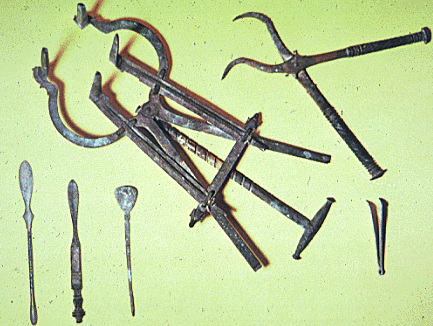
Ancient surgical instruments, including forceps
It would have been one big, bloody, savage mess.
Apart from the usual cuts, slashes, and puncture wounds, the warriors would have suffered shattered bones, fractured skulls, lost limbs, severed arteries, sword, spear and arrow shafts that pushed through armour on into organs.
If you weren’t dead right away, you most likely would have been a short time later.
This is where the ancient field medic could have made the difference for an army. He would have been going through numerous patients in a short period of time. He would have had to decide who was a lost cause, who could no longer fight, and who could be patched up before being sent back out onto the field of slaughter.
The medicus of a Roman legion was an unsung hero whose skill was a product of accumulated centuries of knowledge, study, and experience.
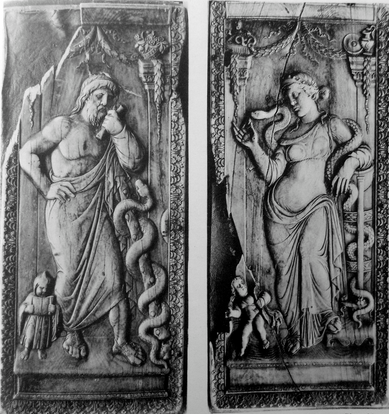
Asklepios and Igia
Many of the physicians in the Roman Empire were Greek, and that’s because Greece was where western medicine was born. Indeed, the ancient Greeks had patron gods of health and healing in the form of Asklepios, Igeia, and sometimes Apollo.
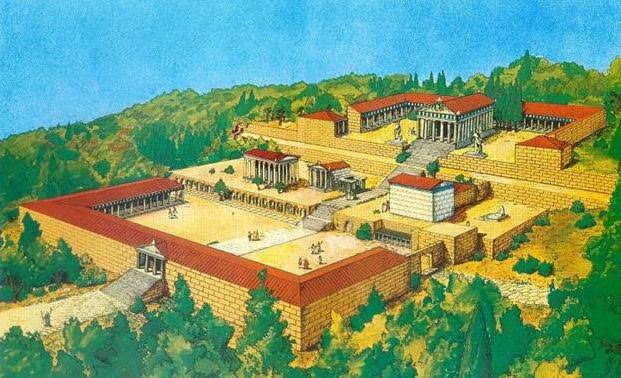
Artist rendering of the Asklepion of Kos
The greatest medical school of the ancient world was in fact on the Aegean island of Cos, where students came from all over the Mediterranean world to learn at the great Asklepion. Hippocrates himself, the 5th century B.C. ‘father of medicine’, was from Cos and said to be a descendant of the god Asklepios himself.
When it comes to Roman medicine, much of it is owed to what discoveries and theories the Greeks had developed before, but with a definite Roman twist.

Hippocrates
The fusion of Greek and Roman medicine in the Empire consisted of two parts: the scientific, and the religious/magical.
The more scientific thinking behind ancient medical practices is a legacy owed to the Greeks, who separated scientific learning from religion. The religious aspects of medicine in the Roman Empire were a Roman introduction.
Because of this fusion of ideas and beliefs, you could sometimes end up with an odd assortment of treatments being prescribed.
‘To alleviate your hypertension over your new business venture, you should take three drops of this tincture before you sleep. You should also sacrifice a white goat to Janus as soon as possible.’
Many Roman deities had some form of healing power so it depended on one’s patron gods, and the nature of the problem, as to which god would receive prayers or votive offerings over another. Amulets and other magical incantations would have been employed as well.

Roman surgical instruments
Romans had a god for everything, and soldiers were especially superstitious.
Greek medical thought rejected the idea of divine intervention, opting more for practicality in the treatment of wounds, and injuries; cleaning and bandaging wounds would have been more logical than putting another talisman about the neck.
All the gods were to be honoured, but in the Greek physician’s mind they had much better things to look after than the stab wound a man received in a Suburan tavern brawl.
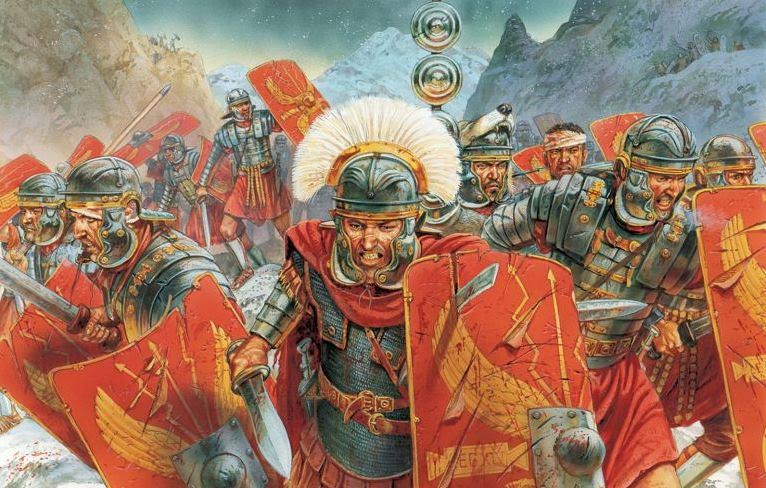
Roman Legionaries (illustrated by Peter Dennis)
For the battlefield medicus, things must have been much simpler than for the physician who was trying to diagnose mysterious ailments. They were faced mostly with physical wounds and employed all manner of surgical instruments such as probes, hooks, forceps, needles and scalpels.
Removing a barbed arrowhead from a warrior’s thigh must have required a little digging.
Of course, in the Roman world, there was no anaesthetic, so successful surgeons would have had to have been not only dexterous and accurate, but also very fast and strong. Luckily, sedatives such as opium and henbane would have helped.
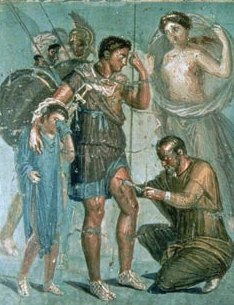
Medic helping a warrior tend a wound
When it came to the treatment of wounds, a medicus would have used wine, vinegar, pitch, and turpentine as antiseptics. However, infection and gangrene would have meant amputation. The latter was probably terrifyingly frequent for soldiers, many of whom would end up begging on the streets of Rome.
It is interesting to note that medicine was one of the few professions that were open to women in the Roman Empire. Female doctors, or medicae, would also have been mainly of Greek origin, and either working with male doctors, or as midwives specializing in childbirth and women’s diseases and disorders. When it came to the army however, most doctors would have been male.
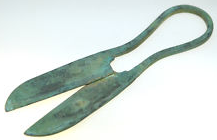
Roman shears
Army surgeons played a key role in spreading and improving Roman medical practice, especially in the treatment of wounds and other injuries. They also helped to gather new treatments from all over the Empire, and disseminated medical knowledge wherever the Legions marched. Many of the herbs and drugs that were used in the Empire were acquired by medics who were on campaign in foreign lands.
Early on, physicians did not enjoy high status. There was no standardized training and many were Greek slaves or freedmen. This began to improve, however, when in 46 B.C. Julius Caesar granted citizenship to all those doctors who were working in the city of Rome.
This last point really hits home when it has become common knowledge that foreign doctors who come to our own countries today find themselves driving taxis or buses because they are not allowed to practice.
Modern governments, take your cue from Caesar!
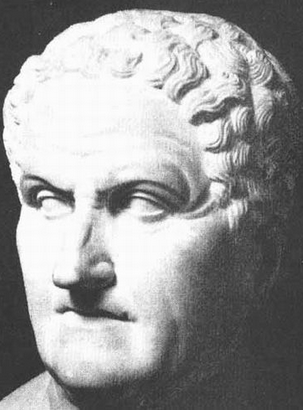
Galen
One of the most famous physicians of the Roman Empire is Galen of Pergamon (A.D. 129-c.199). Galen was a Greek physician and writer who was educated at the sanctuary of Asklepios at Pergamon in Asia Minor.
After working in various cities around the Empire, Galen returned to his home town to become the doctor at the local ludus, or gladiatorial school. He grew tired of that work and moved to Rome in A.D. 162 where he gained a reputation among the elite. He subsequently became the personal physician of the Emperors Marcus Aurelius, Commodus, and for a short time, Septimius Severus.
Galen’s work and writings provided the basis of medical teaching and practice on into the seventeenth century. No doubt many an army medicus referred to Galen’s work at one point or another.
Galen is also an important character in A Dragon among the Eagles, the FREE prequel in the Eagles and Dragon series. In the book, Galen, an old friend and colleague of Lucius Metellus’ late tutor, presents Lucius with a choice that could well change the direction of Lucius’ life. In fact and fiction, Galen is a fascinating person of history.

Re-created ancient surgical instruments
I’ve but barely scratched the vast surface of this topic.
For some, there is this assumption that ancient medicine was somehow false, crude and barbaric. But modern western medicine owes much to the Greeks and Romans, civilian and military, who travelled the Empire caring for their troops and gathering what knowledge and knowhow they could.
The fusion of science, religious practice, and magic provides for a fascinating mix. In truth, medical practices in medieval Europe might have been more barbaric than in the ancient world.
Thank you for reading, and may Asklepios, Igeia and Apollo grant you good health!

12th century mural of Galen and Hippocrates in conversation
Ancient Everyday – Garum: MSG of the Roman World
Here is lordly garum, a costly gift, made from the blood
of a still-gasping mackerel
(Marcus Valerius Martialis)
If you are a fan of the Roman Empire, or read any fiction or non-fiction about Roman civilization, chances are you will come across a certain salty condiment that many ancients went mad for.
In this edition of Ancient Everyday, we’re going to look at garum.
Now, let me say this: I’m not a big fish-eater.
Yes, I know, I’m half island Greek and don’t all Greeks love to eat fish?
Not this one.
So let me tell you that when I first found out what garum was, what it was made of, I had a titanic wave of nausea wash over me.
But whereas garum would have had me running, most Romans across the Empire loved this stuff!
So, as this is supposed to be an educational piece, I shall set aside my disgust and press on in the interests of history.
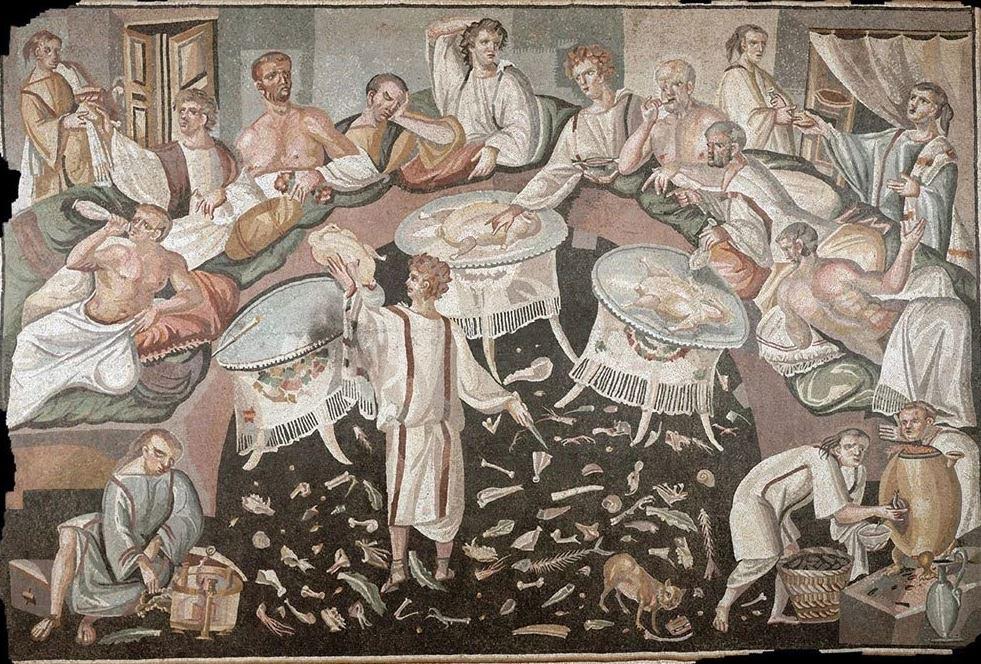
A Roman Banquet – spot the hints of garum!
So, what exactly is garum?
Basically, it is fermented fish sauce that was used as a condiment on just about anything. It was created from fish intestines and other parts mixed with salt.
It was immensely popular and supposedly quite healthy in that it was packed with protein, amino acids, minerals and vitamin B.
It was also rich in monosodium glutamate. That’s right…MSG!
Many of you will know MSG as a long-standing chemical compound used in modern food flavouring. It’s been called a ‘silent killer’, and linked to adverse health effects including something called ‘Chinese restaurant syndrome’.

Fish bits used to make garum
Now I don’t know if the Romans experienced anything like garumitis (today’s made-up word), and that doesn’t really matter here. What we need to know is that Romans put it on everything from seafood and chicken, to olives, porridge and more. It was the food seasoning of choice for those who could afford it.
They couldn’t get enough of garum!
Here is Pliny the Elder, the famed natural historian, speaking about garum:
Another liquid, too, of a very exquisite nature, is that known as “garum:” it is prepared from the intestines of fish and various parts which would otherwise be thrown away, macerated in salt; so that it is, in fact, the result of their putrefaction. Garum was formerly prepared from a fish, called “garos” by the Greeks; who assert, also, that a fumigation made with its head has the effect of bringing away the afterbirth.
At the present day, however, the most esteemed kind of garum is that prepared from the scomber, in the fisheries of Carthago Spartaria: it is known as “garum of the allies,” and for a couple of congii we have to pay but little less than one thousand sesterces. Indeed, there is no liquid hardly, with the exception of the unguents, that has sold at higher prices of late; so much so, that the nations which produce it have become quite ennobled thereby. There are fisheries, too, of the scomber on the coasts of Mauretania and at Carteia in Bætica, near the Straits which lie at the entrance to the Ocean; this being the only use that is made of the fish. For the production of garum, Clazomenæ is also famed, Pompeii, too, and Leptis; while for their muria, Antipolis, Thurii, and of late, Dalmatia, enjoy a high reputation.
(Pliny the Elder, Natural History 31.43)
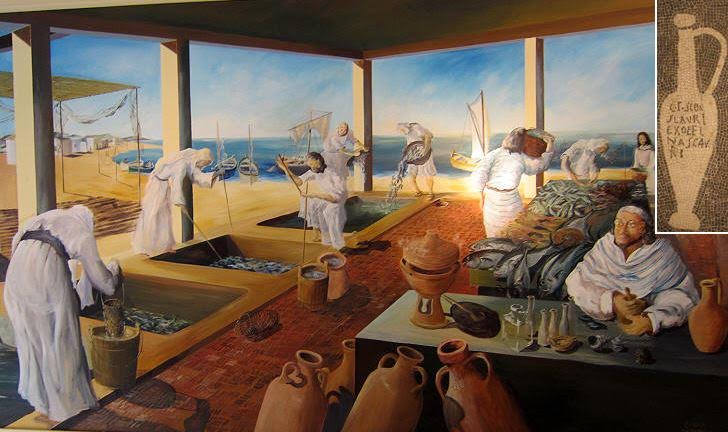
Artist impression of a garum factory
After the garum liquid was extracted, the macerated remains, a pulp called allec, was used by the poorer classes, those who could not afford garum, to flavour their porridge – a grisly tapenade of sorts.
FYI – I prefer maple syrup on my porridge.
Garum production and export was a BIG industry in the Roman Empire, with production centres, a system of distribution by land and sea, amphora marked by the producer etc. etc.
It was also a smelly industry, for obvious reasons, so garum factories were often located outside of cities.

Garum amphorae
Just as with wine and olive oil, there were different grades of garum that were priced accordingly, as Pliny alludes to in the quote above.
Not all gara were created equal, and there were different recipes from different ports. The best was said to be from the Iberian Peninsula, in Hispania, particularly from Carthago Novo (Cartagena), and Gades (modern Cadiz in Andalusia).
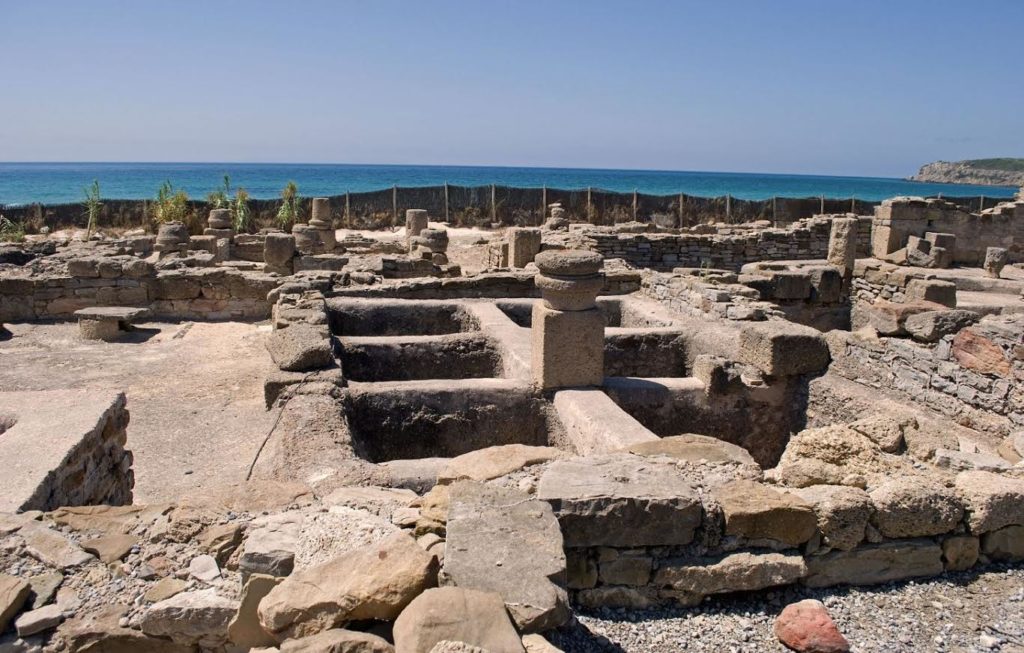
Ruins of a garum factory in Spain
Different fish were used in garum too, depending on the company, recipe, and place where it was made. Some of the most common were mackerel, anchovies, sprats, sardines, tuna, and even shell fish. Archaeology has also revealed the production of kosher garum among Roman Jews.
You might think that every person in the Empire loved garum, but not everyone was a fan, including Seneca, whose family was from Hispania:
What? Do you suppose that those oysters, a sluggish food fattened on slime, do not weigh one down with mud-begotten heaviness? What? Do you not think that the so-called “Sauce from the Provinces,” the costly extract of poisonous fish, burns up the stomach with its salted putrefaction? What? Do you judge that the corrupted dishes which a man swallows almost burning from the kitchen fire, are quenched in the digestive system without doing harm? How repulsive, then, and how unhealthy are their belchings, and how disgusted men are with themselves when they breathe forth the fumes of yesterday’s debauch! You may be sure that their food is not being digested, but is rotting.
(Seneca, Ad Lucilium Epistulae Morales 95.25)
Seneca seemed like a rather more health-conscious person, so, perhaps like people today who ask for their Chinese food without MSG, he was aware (or disgusted by) the adverse effects of consuming too much of the over-pricey liquid that Pliny believed was “exquisite in nature”.
I suppose the tastes of the people in the Roman world were as vast and varied as the Empire itself.

Modern garum
For myself, I’ll give garum or its modern equivalent a miss, but that’s not to say people don’t go in for it today. Maybe you do as well?
Thank you for reading!
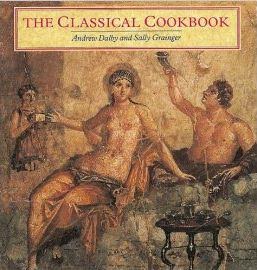
If you are curious about an ancient recipe that uses garum, and you want to try it out, the Classical Cookbook has a few. Here is one by Apicius for soft-boiled eggs (page 117) that you may want to try.
Ingredients:
– 4 oz pine kernels, soaked overnight in white wine
– 1 teaspoon chopped fresh lovage or celery leaf
– 1 tablespoon of Garum (Fish Sauce)
– 1 tablespoon of honey
– 1 tablespoon of white wine vinegar
– ½ teaspoon of ground black pepper
– 4 soft-boiled eggs
Strain the pine kernels and pound or process them to a smooth paste. Add the lovage, fish sauce, honey, vinegar and pepper and continue to pound or process until you have a smooth mixture. Finish the dish as if you were making egg mayonnaise and garnish with cucumber.
Bon appétit! Or rather, Bene sapiat!
Ancient Everyday – Happy Hour in the Roman Empire
Hello history-lovers!
It’s been a while since the last Ancient Everyday post back in April, so I thought it high-time for another one.
Last time we looked at Childbirth in the Ancient World, but this time we’re going to be a bit more light-hearted. Today, I wanted to look at drinking cups in the Roman Empire.
So, pour yourself a glass of your favourite vintage, sit back, and join me for a brief look at the variety of cups the Romans used to pour everything from water to nectar down their throats!
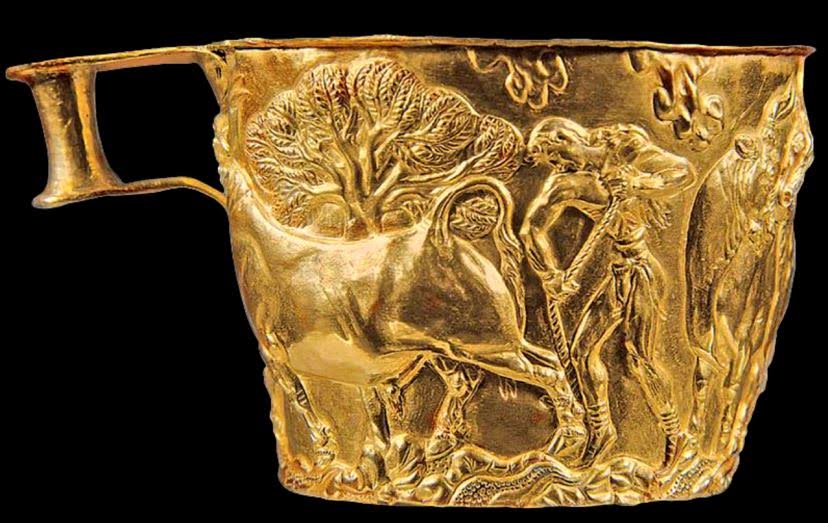
Mycenaean Greek Bronze Age golden cup from a Laconian tomb
Cups, throughout history, have come in an astonishing variety of shapes, sizes and materials. When I think of Romans drinking, the first image to come to my mind of rich aristocrats drinking from golden cups.
But there was much more to it than that! If you go into any museum with a Roman collection, chances are you’ll find a wide variety used every day by regular Romans. In fact, golden cups like the ancient Greek one above, were more of a rarity in the Roman Empire. Silver was much more common, and even that was more common among the ‘elite’.
Let’s start at the bottom, shall we?
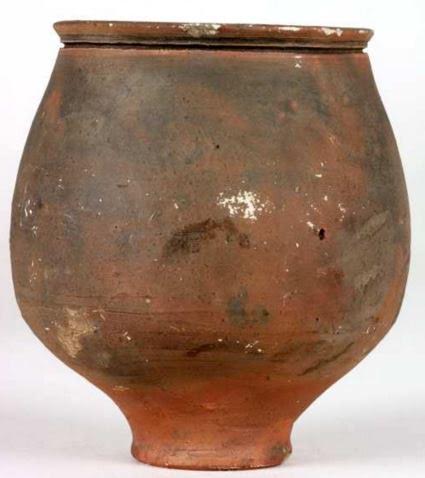
Plain Roman clay cup
The most basic type of wine that an average Roman would have drunk was called posca. This was a mixture of sour wine and vinegar which eventually became the normal ration among the men of the legions, as well as the poorer classes in the Empire.
And they did not drink this sour, sometimes herby mixture from silver cups. No. Posca was most often drunk from basic wood, bone, or more likely, unornamented clay cups. These were rough, unfinished, and mass produced cups. They were cheap and served one purpose – to get the drink from point A (the table or jar) to point B (one’s mouth).
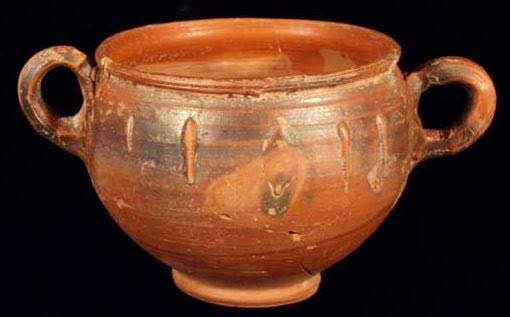
Two-handled Roman Cup clay 1st cent. A.D.
After this mean style of cup came what is probably the most recognizable Roman cup around – the Terra Sigillata (‘clay bearing images’). This style is often referred to Aretine ware (made in Arezzo), and Samian ware (made in Roman Gaul).
These types of cups were mass produced in specific factories, or fabricae, around the Empire. They were relatively affordable, but obviously cost more than the rough, undecorated cups.
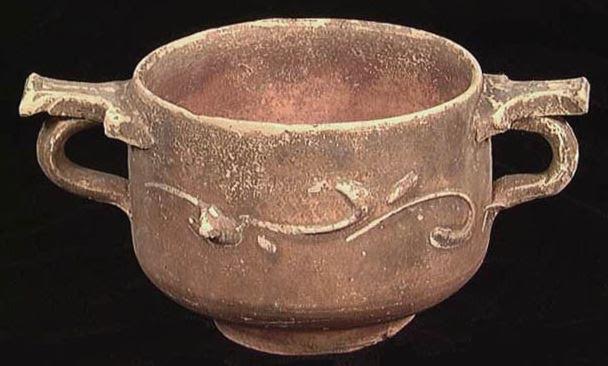
Terra Sigillata skyphos style cup
Something like Samian ware didn’t just come in cup form either! You could get a whole set of Samian dishes and serving platters to match your cups, all of them adorned with mythological, banquet or gladiatorial combat scenes. Or for the more frisky of Romans, love scenes or orgies. A set of these might have been nice on the Roman bridal registry!
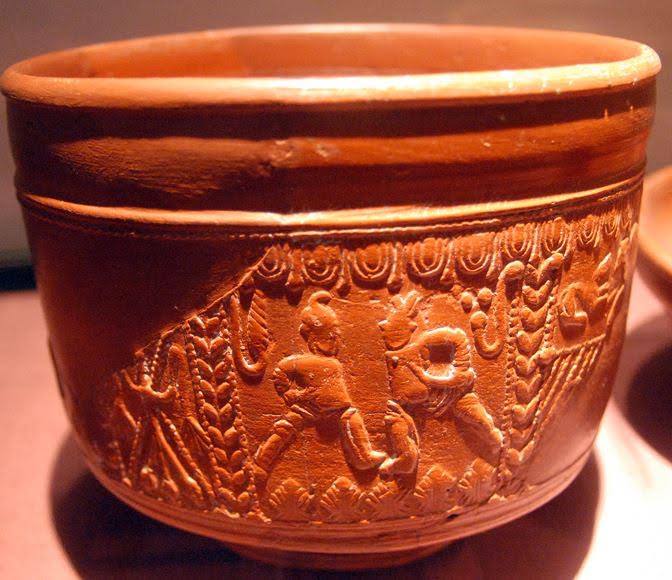
Samian cup 1st cent A.D. – Features gladiatorial combat scenes
Some factories specialized in Roman Black ware, also known as Castor ware. Maybe these were intended for a more subdued household…
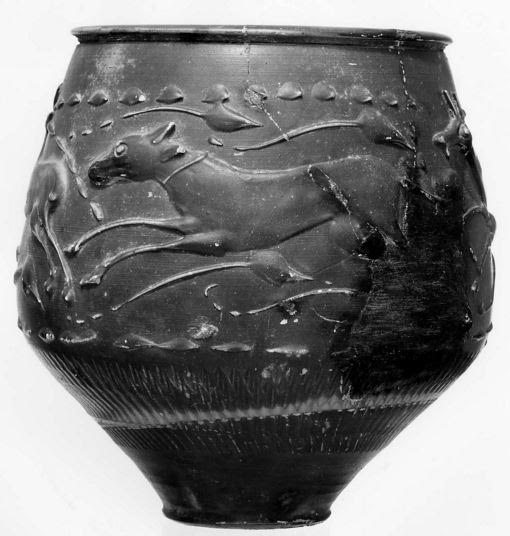
Roman black ware cup, or ‘Castor Ware’
A step up on the price list would be something that the Romans came to perfect – Glass ware. When it came to making and using glass, no one did it better than the Romans. And it wasn’t just for windows, phials, perfume bottles or vases. They also made beautiful drinking cups and beakers out of glass.
It took the Romans time, however, to get it right and outdo the Hellenistic kingdoms in the art of glass-making. It wasn’t until later, in the reign of Augustus and his Pax Romana, that the Roman glass industry really took off. In part, the development of glass-blowing in the first century A.D. allowed the Romans to produce more glass pieces with fewer flaws.
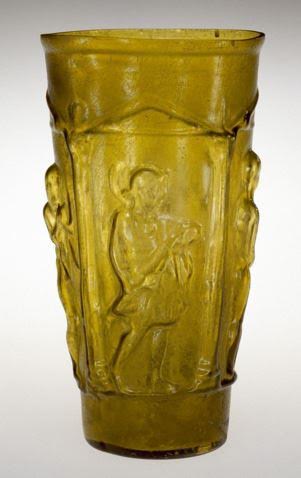
Roman glass beaker
Roman glasses were available in a variety of dazzling colours and thicknesses, from green and yellow (like the one above), to the brilliant blue glass that they became so well-known for.
Roman glass-making was a true art-form with varying levels of quality, of course, but the main component in Roman glass was beach sand.
When you go into a museum and see collections of Roman glass objects, you can’t help but stare at the colours and the delicate shape of some of the objects. They look like they were meant to adorn the dressing table of a fine lady, or indeed sipped from in an intimate gathering.
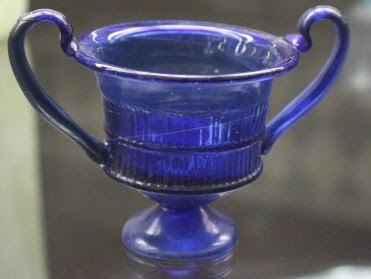
Roman blue glass Kantharos
When it comes down to it though, the choice of drinking cup for a gathering of aristocratic patricians would probably have been silver. The hosts would have pulled out their best pieces in order to show off.
These would not have been plain, smooth-surfaced, silver cups, however, but rather works of art depicting elaborate scenes from mythology or other themes recognizable to rich Romans.

Silver Roman Cup – 1st cent. AD
As with Samian Ware, there were also entire silver sets of plates, platters, pitchers, beakers, serving trays, cups and more, and these would have cost a fortune. A set like that would have been used to impress guests, to enjoy the luxuries of the Empire.
An example of a silver hoard like this is the famous Berthouville treasure, and the cup below is just one of the many intricately crafted items found in this treasure.
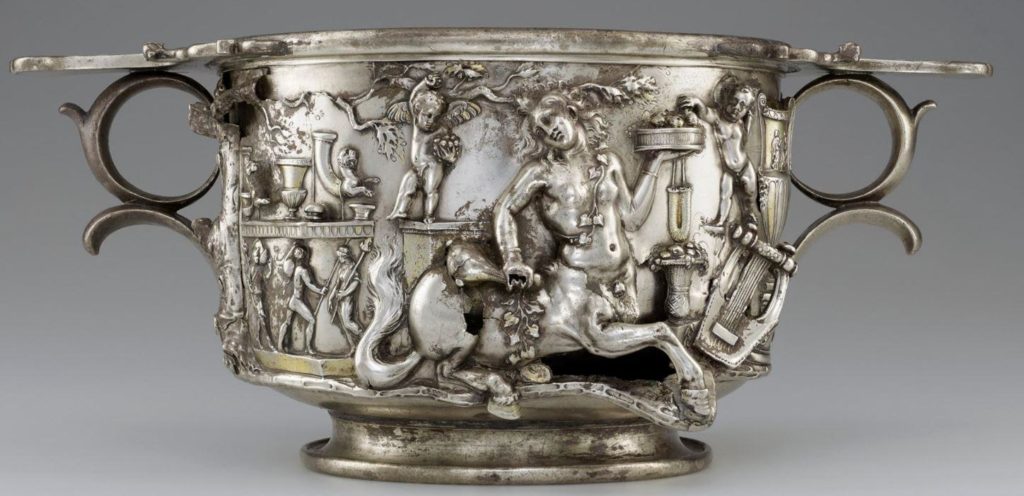
Roman Silver cup from Berthouville Treasure
Isn’t that stunning? I can just imagine sipping a fine Falernian or Chian wine out of that cup while lounging in a peristyle garden beneath an olive tree. Ahh…
Believe it or not, there is yet one more step above such silvery works of art, and that is the type of cup that was commissioned by a very wealthy person from a highly skilled artisan, or, one might say, magician!
Enter the Lycurgus Cup.
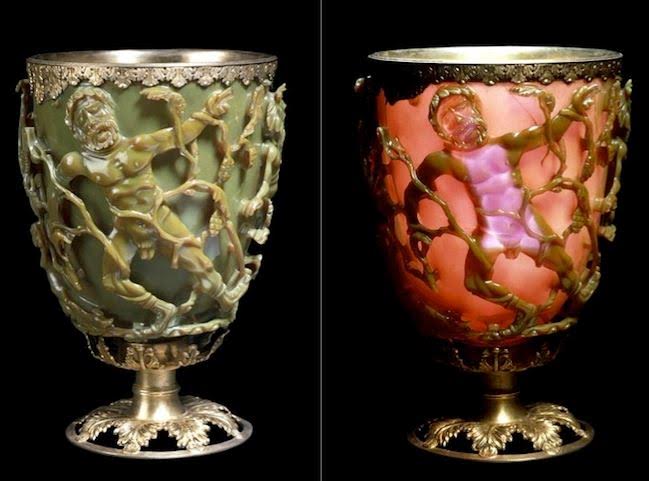
Split image of the Lycurgus Cup lit from the front (left) and from the back (right)
This piece is one-of-a-kind, and would have cost a fortune, but the person who would have commissioned this was probably not someone who worried about how many denarii they had in the vault. The owner of this cup probably dealt in talents (71 Roman lbs. in gold), and drank only the finest vintages.
The Lycurgus Cup, so named after the mythological scene on it, is what is called a Roman Glass ‘cage cup’. I won’t go into the details of how it was made, but you can read more by clicking HERE.
What is spectacular about it is the type of glass used behind the ornate, gilded bronze cage. The glass, known as dichroic glass, actually changes colour when light hits it from the front, compared to when the light comes from behind, as seen in the split image above.
To be honest, I can’t imagine drinking out of such a cup. I’d be too afraid to break it!
Cheers everyone!
Or, as the Romans might say, Salutaria!
Thank you for reading.
Ancient Everyday – Childbirth in the Ancient World
It’s been a while since I last posted in the Ancient Everyday series.
Last year we looked at the ritual of going to the public baths, the interesting experience of using a public toilet, and the use of mirrors in the ancient world.
Today, we’re going to take a very brief look at childbirth in ancient Egypt, Greece, and Rome.
Now, as a man, my input and views on childbirth are somewhat limited, so I would invite my female readers out there to jump in with their comments at any time. I’m a father, and I’ve been present at the birth of my own children, but I would never presume to fully comprehend mysteries, and agonies, that women go through when it comes to bringing a tiny human into the world.
Let’s face it, we’re extremely lucky today as far as obstetrics and the technologies we have to help mothers and children safely navigate the process of pregnancy and birth.
That was not the case in the ancient world. Pregnancy and birth were risky affairs, and as with many aspects of life, the ancients called on specific gods and goddesses for help when it came to childbearing and birth.
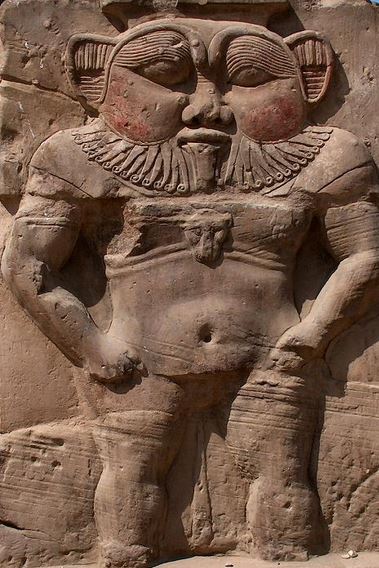
Egyptian God, Bes
The Egyptians offered prayers to the god Bes, a god of marriage and jollity, but also a protector of women and children in childbirth. Bes was not your typical Egyptian god. He is portrayed as an ugly dwarf with a feather crown, sometimes holding a tambourine.
His consort, Tauert, was also prayed to as someone who assisted all females, regardless of station, in childbirth. Tauert was portrayed as a pregnant, female hippopotamus.
In ancient Greece the goddess two whom prayers and offerings were made was Artemis, under her two epithets Kourotrophos (nurse) and Locheia (helper in childbirth).
Now it might seem odd that people prayed to the virgin goddess for protection in childbirth, but in myth, Artemis was said to have been present when Leto, her mother, gave birth to Apollo on Delos. She was considered, in some ways, the first midwife.

Artemis
It is interesting to note ancient Greeks believed that women who died suddenly in childbirth were helped to a painless death by Artemis who showed them mercy by piercing them with one of her arrows.
The ancient Greeks also prayed to Hecate as a goddess of women and nurturer of children, as well as Hera, the Queen of the Gods who sometimes served as a goddess of childbirth in her capacity as goddess of marriage.
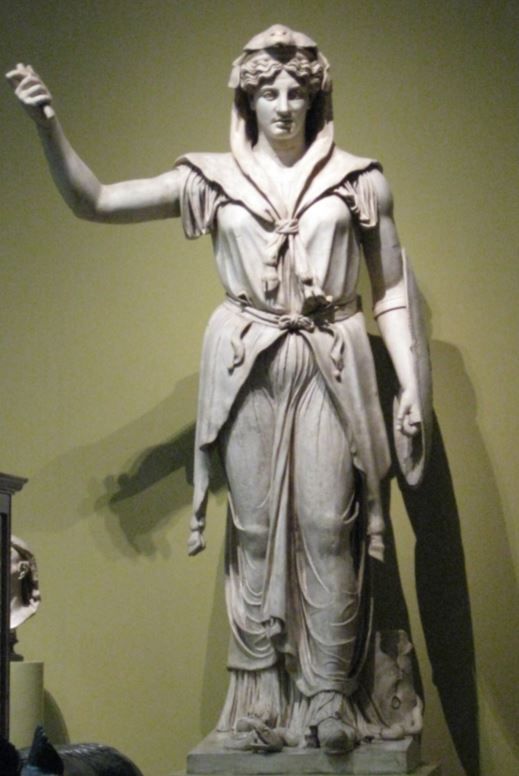
Roman Goddess, Juno – Queen of the Gods
The Romans had many gods and goddesses to whom they prayed for help, and Juno, Queen of the Gods, was first and foremost under the epithets of Lucina, and Opigena.
Another goddess with a major role to play was Carmentis, a water goddess who was also a prophetic goddess of protection in childbirth. Carmentis had her own festival, the Carmentalia, and a temple on the Capitoline Hill.
A third goddess whom the Romans prayed to for a safe and successful childbirth was Matuta, the goddess of dawn and young growth.
It must have been a comfort to have so many gods to pray to, but that may also be indicative of the high risks involved.
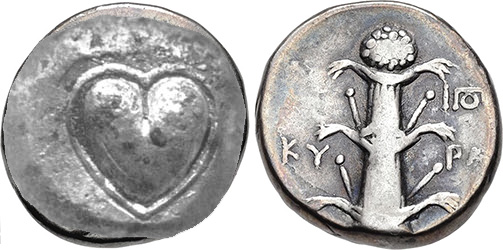
Ancient Coin with image of Silphium plant on one side, and heart-shaped Silphium seed on the other
Because it was so dangerous to bring a child into the world, and because families could not always afford to feed or provide dowries for all their children, contraception was something that was used in ancient Egypt, Greece, and Rome.
Most of the methods used seem to be herb and plant-based, and included things like acacia, honey, Queen Anne’s Lace, date palm, willow, Artemisia, myrrh, and the now extinct silphium plant, among others. Some of these are apparently used in spermicides today.
The Egyptian Kahun Papyrus from c. 1850 B.C. actually contains a lot of information on birth control and is the oldest known gynaecological treatise.

Egyptian Kahun Papyrus – The World’s first known gynaecological treatise
But we are talking about having children in the ancient world. Today, most husbands (I would hope) are in the room to support their wives and be there when their child are born. It happens at the hospital or birthing centre (most of the time), and there is a doctor/obstetrician to help the delivery.
In the ancient world, births took place at home. There were no hospitals, except for those at healing centres like Kos and Epidaurus, and oftentimes, anyone who had been ‘in touch’ with childbirth was not permitted to enter sacred sanctuaries anyway for fear of contaminating the place.
In Egypt, Greece, and Rome, midwifes were a constant. Today, midwifery seems to have made a big comeback, but in the ancient world, the midwife was always the one who helped women through childbirth. Their skills and knowledge were considerable. The only time a doctor might have been called in ancient Greece and Rome was if there were complications.

Egyptian birth – temple relief at the Ancient Egyptian Dendera Complex depicts a woman giving birth while squatting and attended by the two goddesses
It appears that in most cases, no men were present at the birth of a child, though there were often several people in attendance, including the midwife, the women of the household (mothers, grandmothers, aunts etc.), and any female slaves that were needed to help.
It was not considered proper for men to be present, and the only man who might have been there was the doctor if he was called.
What about the position for giving birth?
Well, in Egypt, it seems that women often knelt in a shaded spot or shelter to give birth.
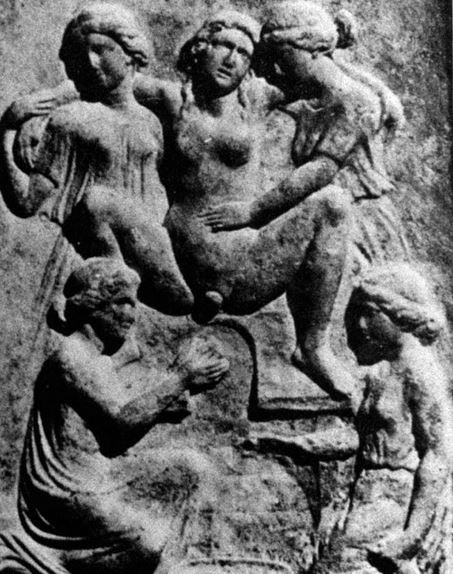
Relief of a woman in birthing chair
With modern hospital beds, women are in more of a lying-down position, with their backs propped up to give birth.
Interestingly, in ancient Greece and Rome, and in later centuries, birthing chairs were used. This was basically a wooden chair with arms, but no seat.
The midwife would kneel on the floor before the chair and help the woman from there, her hands wrapped in linen or papyrus so that the baby did not slip when she caught it.
It may be that couches were also used for giving birth, but I do wonder if midwives in ancient Greece or Rome might have had birthing chairs as part of their professional kit.
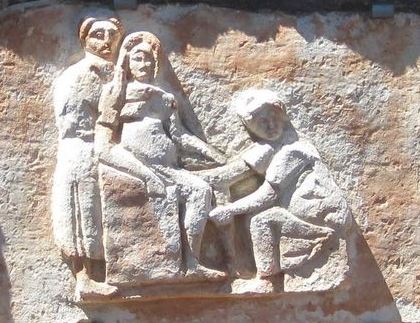
Roman birthing chair and midwife from plaque in Ostia
Mortality rates for women and children in pregnancy and childbirth were high in the ancient world, and from the little that I’ve read, the risk of death was extremely high in ancient Egypt. Many women died in pregnancy and childbirth, and infants who were born often did not survive the first few months.
Once a child was born, there was usually a ceremony for the naming and blessing of the child.
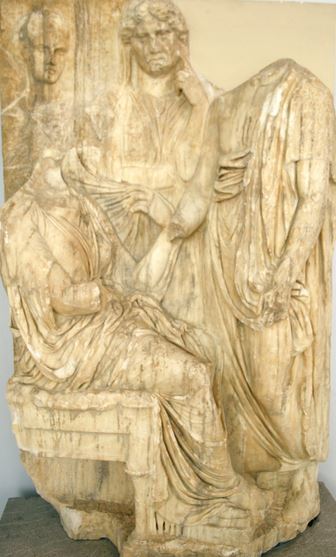
Funerary monument of a woman who died in childbirth showing her bidding farewell to her husband, mother and nurse who will care for her child
I could not find information on the specifics of an Egyptian ceremony (Egyptology is not my area of expertise), but I have read that water and ritual washing may have been a part of such a ceremony for newborns since water played a large part in Egyptian religious rituals. Perhaps my Egyptologist friends out there can shed some light on this subject?
In ancient Greece, on the fifth or seventh day after a child was born, there was a purification ceremony and feast called the amphidromia, at which the child received its name. This involved a ritual and an evening feast to which guests brought presents for the child. If a boy was born, the house was decorated on the outside with olive branches. If it was a girl, the outer decoration consisted of garlands of wool.
In ancient Rome, the naming ceremony was called a lustratio, and this took place nine days after the birth of the child. At this, offerings were made to the gods, there was a feast, and the child was introduced to guests.
In chapter twenty-one of my book, Killing the Hydra, I write about a Roman lustratio.
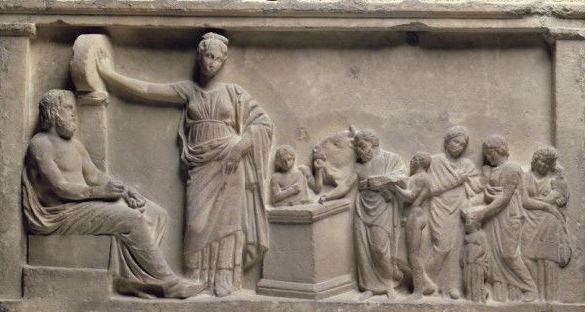
A family making their offerings to the Gods
Most people today cannot view the successful birth of a child with anything but gladness. And rightly so! It’s a beautiful thing, and most parents are happy when their child is born healthy, no matter if it is a boy or a girl.
However, in the ancient world, views of family and children could be quite different from our own.
It seems that ancient Egyptians were devoted to their families and that they loved their children. This can be seen in the many images that survive of happy families, babies in their mothers’ arms, and children playing.
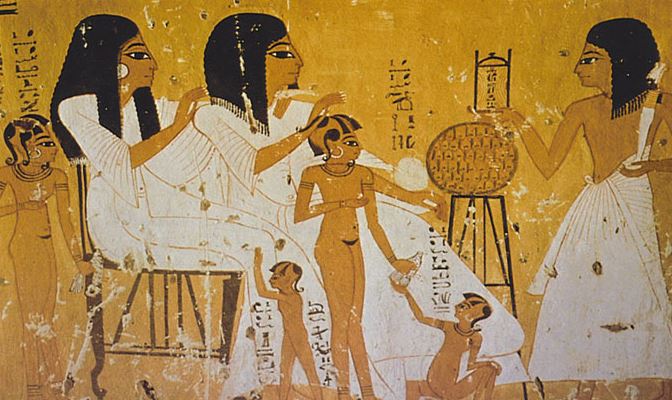
Egyptian women and children
In ancient Greece and Rome, children were meant to be less visible, and stayed inside with the women. At birth, a Greek father or guardian decided whether to keep a child. In Rome as well, the paterfamilias had the power of life and death over his family members, and this included newborn infants whom the father could deny the right to be reared.
Children could be exposed or killed in ancient Greece and Rome, and had no place in public life.
Practices also differed by place. For instance, in ancient Athens, if a child was kept, it was swaddled, whereas in Sparta children were not swaddled at all, presumably to start toughening them up, or cull the weak.
It certainly seems harsh to our modern sensibilities, but the truth is that if a child managed to survive birth, decisions about their usefulness and whether to keep them were more often based on the sex, the number of children the family already had, ability to provide for that child, the future need for a dowry, and general health.
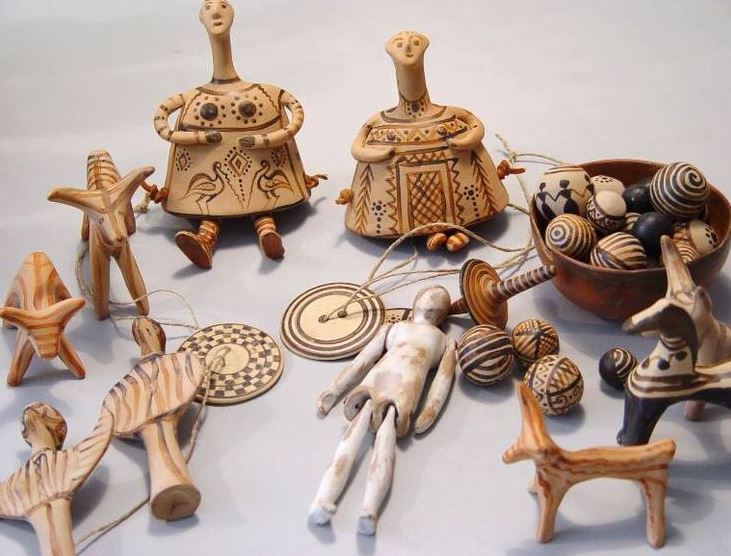
Children’s toys from ancient Greece
It’s odd, but most of the time, I tend to think that the past was much more exciting and interesting, more beautiful than our chaotic, modern society. I think most historians feel they were born in the wrong age!
But when I read about things like pregnancy, health, childbirth, and children in the ancient world, it makes me grateful we live in the age we do.
It’s not perfect by any stretch, but as far as childbirth, I would give that part of the ancient everyday a miss.

Statues of children from the sanctuary of Artemis at Brauron, Attica, site of an ancient orphanage
And let’s not think that all children in ancient Greece and Rome were treated badly. It is my hope that, despite the social mores of those sometimes harsher societies, Nature instilled in the mother and father of most children a love and need to care for their offspring that is timeless and powerful.
As ever, thanks for reading!

Aphrodite and Anchises with baby Aeneas
Remember! If you haven’t already done so, sign-up for the Eagles and Dragons / Writing the Past newsletter by CLICKING HERE! There are a lot of exciting things coming up this year, and Newsletter subscribers always get some special treatment!
Ancient Everyday – Time for a Bath
Showering, bathing and generally keeping clean is something that we take for granted today. For most people, washing is part of the daily routine.
If you look at the Middle Ages, this was not the case. In fact, medieval people were pretty filthy. This isn’t surprising as bathing was considered a sin by many.
This wasn’t the case for ancient Romans, thank the gods.
As we do today, the Romans bathed and washed regularly, and as with going to the toilet, bathing was yet another very social activity for Romans.
Throughout the Roman Empire, public and private baths were common, owing something to the situating of bath houses over hot springs, and their ingenious use of aqueducts which brought water into the cities over great distances.
Baths and bathing complexes, of course, varied widely in size and the level of sophistication, whether the small pools and tubs of private balneae, or the massive imperial complexes called thermae. Whatever the size, there were some common attributes to most public baths across the Empire.
The Apodyterium
This was a sort of changing room where visitors to the baths would undress and leave their clothes in niches in the walls, not unlike today. Slaves were in attendance to give out towels and take care of your items. However, not unlike today, theft was common in the apodyterium, so wealthier patrons brought their slaves along to carry their possessions for them.
The Palaestra
The palaestra was the workout area where some patrons would exert themselves before going into the baths themselves. Just as people hit the gym today, so the Romans exercised on the sands of the palaestra by wrestling, boxing, lifting stone or lead weights, and other activities. The scene here would have been one of competition, of grunting, and sweating. It could get pretty loud, as attested to by the Roman Seneca:
“I live over a public bath-house. Just imagine every kind of annoying noise! The sturdy gentleman does his exercise with lead weights; when he is working hard (or pretending to) I can hear him grunt; when he breathes out, I can hear him panting in high pitched tones. Or I might notice some lazy fellow, content with a cheap rub-down, and hear the blows of the hand slapping his shoulders. The sound varies, depending on whether the massager hits with a flat or hollow hand. To all of this, you can add the arrest of the occasional pickpocket; there’s also the racket made by the man who loves to hear his own voice in the bath or the chap who dives in with a lot of noise and splashing.” (Seneca in AD 50)
But the palaestra was not just for men. In ancient Rome, women too were permitted to exercise and stay fit. One famous mosaic shows a group of women engaged in exercise on the palaestra floor, though this was probably done at a different time, or in a separate area from the men.
The Tepidarium
After the exertions of the palaestra, patrons would then move to the first room of the baths proper, the tepidarium. As the name implies, this was the ‘warm’ room where one could begin to heat up and start sweating. In some cases, the tepidarium had a warm water bath in which bathers could submerse themselves, but in other instances, it was just a room of warm air, thanks to the underground, and in-wall heating from the system of hypocausts that were used to heat the baths.
The tepidarium was often highly ornate too. Men and women could lounge and talk business, gossip or anything else while being rubbed down with oils which the Romans used instead of soap. Once they were warm enough, and the oils had started to go to work on their pores, bathers moved to the next room.
The Caldarium
The caldarium was the hottest room in the bath complex, located as it was directly above the hypocaust furnace. This was the equivalent of the modern sauna where patrons would be more still, sweat, and scrape the mixture of oil and dirt from their skin with a tool called a strigil.
The caldarium had a basin with cold water for patrons to wet themselves with, but also a hot pool if they wanted to soak some more. The heat from the caldarium is what brought the dirt to the surface and aided with the cleaning of their bodies in concert with the oil that was rubbed on.
The Frigidarium
After the tepidarium and caldarium, it was time to close the pores and revive, and what better way to do this than by jumping into a cold pool of water.
Welcome to the frigidarium! One can imagine the echo of people’s squeals as they landed in the cold water, the shock running through them in a great wake-up call. Some of the larger bath complexes would also have included a swimming pool at this stage, in which patrons could swim a few laps.
The frigidarium was not a room patrons would spend too much time in. Who would want to when the next step is so enjoyable?
Massages, Food, and more Socializing
After having made his/her way through the various rooms of the bathing complex, many Romans would opt to get a massage. Either they had their own slaves oil them again and work away at their muscles, or they would have one of the bathing complex’s massage slaves work on them.
What better way to work out the knots owed to debates in the Senate house, fights on the battlefield, haggling in the imperial fora or other activities than to have fragrant oils massaged into your newly cleaned skin.
I tell you, the Romans knew what they were doing with this ancient toilette ritual! I’m relaxed just thinking about it.
After the massage, and dressing again in the apodyterium, some of the larger complexes had tabernae attached where patrons could go and eat, have a drink, gamble a bit at games, and most importantly, socialize.
That’s the interesting thing about public baths in the Roman Empire; they weren’t just facilities intended to curb public health issues by keeping the populace clean and hygienic, they were also the community centres, or community hubs, of the ancient world.
They were a bit of an equalizer too. In the Colosseum or Circus Maximus, the rich might have had the better seats with cushions, but in the thermae of the Empire, when naked, everyone was standing on equal footing.
So, next time you visit your, gym, local pool, or community centre, remember that you are participating in a highly social activity, owed mainly to the ingenuity of the Romans.
Thank you for reading.
For a bit more information, check out the video below from the series What the Romans Did for Us, with Adam Hart Davis. In this episode, he looks at Roman baths among other things related to Roman luxury!

